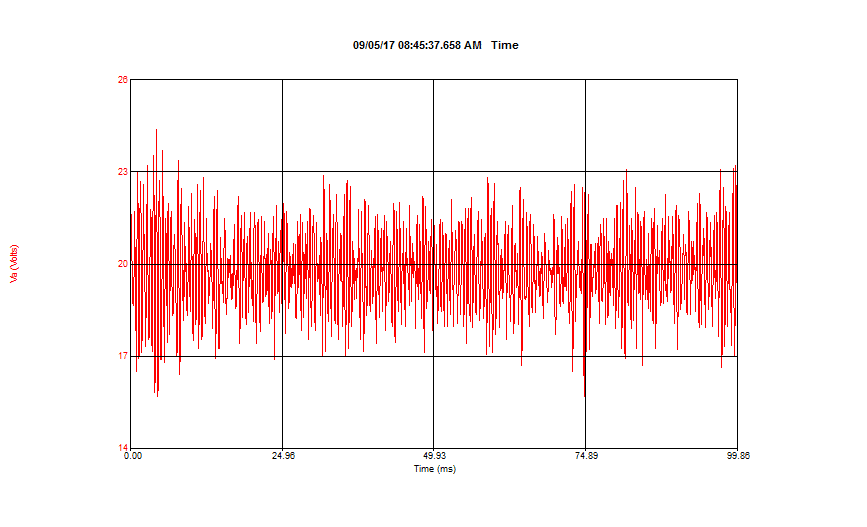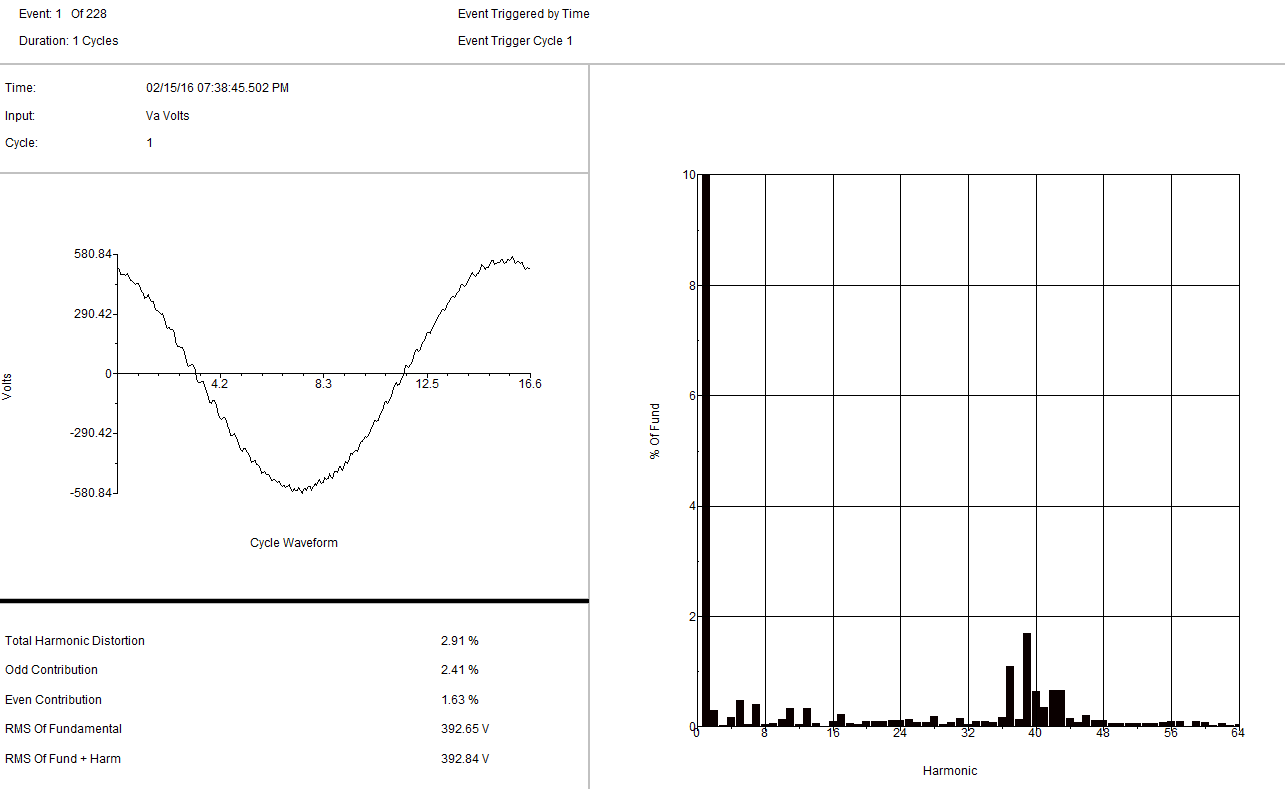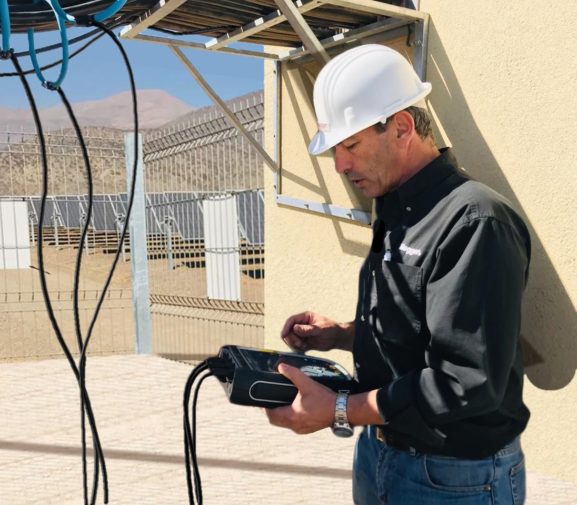By Andrew Sagl, product manager, Megger
Power quality issues that arise with solar energy
As solar power becomes more popular and prominent, it is important to remember that the electric grid is a dynamic system. Solar energy requires many individual pieces of equipment to construct and operate a system properly. When something gets attached to the grid, it can change the system to a certain degree. When solar systems are attached to the grid, we may see power quality problems occur for both the solar site and the utility.
The output of a solar panel is always fluctuating. This output goes through an inverter in order to convert the DC to AC. An unconditioned AC voltage can create various power quality issues.
Figure 1: Pictured is a graph of the DC output of a solar panel

High voltage is a power quality issue that can be faced when using solar panels. When the solar array is placed on a location, that location can experience higher voltage than normal, depending on the voltage conditioning equipment.
Standard recommendations for low voltage systems in both Europe and the United States should be within +/‐10% of the nominal voltage for 95% of the time. It is also important that the voltage does not exceed +10% or ‐15% of nominal for 100% of the time. Verifying these RMS values are important because high voltages can cause premature motor and lighting failures.
High voltage can cause core saturation and excessive heating in motors. This can create higher than normal inrush currents in motors that are found in air conditioners, washer, dryers and refrigerators that turn on and off multiple times a day.
Premature lighting failure is seen in both incandescent and florescent lighting. High voltage causes these lights to burn brighter, producing more heat and reducing their life cycle.
Unbalance and transients in solar equipment
Unbalance in voltage or between phases is another problem utilities will face when solar is used. If the solar array is not connected to the phases, then an unbalanced voltage condition can occur. The more single phase solar arrays connected to the grid, the worse the problem becomes.
Unbalanced voltages can become a very serious problem in 3-phase motors. The resulting current unbalance in a motor can be 6 to 10 times higher than the voltage unbalance that creates it. This causes excessive heating and can burn out coils. A voltage unbalance of just 2% can equal a current unbalance of up to 20%. So it is important that a voltage negative sequence unbalance does not exceed 2% for 95% of the time. In order to combat this, utilities are having to change the tap settings on their transformers to compensate for these unbalanced conditions.
Transients are yet another issue that can arise when using solar power. Solar panels react nearly instantaneously to changes in solar radiation. The bandwidth of the solar radiation that effects solar panels is wider than our visual range, meaning even on clear days, the solar panels can be changing rapidly due to pollutants we do not see.
If the solar system does not have proper voltage conditioning, this can create high-speed transients. These high-speed transients can have adverse impacts on residential and commercial electronics. Modern electronics do have input filters that can filter out transients. These can fail when being exposed to repeated transients, leading to failures in these electronic devices, like flat screen televisions, microwave ovens and computer equipment.
The problem with harmonics
Harmonics are yet another area to be looked at when using solar energy. Inverters convert the DC current to AC current. These non-linear devices can create harmonics. Inverters tend to operate at relatively higher frequencies in order to maximize their efficiency. However, the higher the frequency the inverter functions at, the higher order harmonics it creates. It is not uncommon to see harmonic orders up above the 40th order.
Figure 2: Graph showing harmful harmonics in a system

Harmonics generate eddy currents in wires. These types of currents cause what is known as skin effect, which generates heat in wires. Coils are just wound wire. Therefore, harmonics generate heating effects in equipment that contains coils, like transformers and motors. The higher the frequency of the harmonic, the greater the eddy currents, the greater the skin effect, the more heating. High harmonic current can cause premature failures in motors and transformers as well as sensitive electronics.
Distributed power generation and power reversal issues
Power reversal can also cause issues when using solar panels. The standard distribution power grid was designed in a radial fashion, meaning it was designed with the assumption that power would always flow from the source to the load. With the spread of distributed energy resources (DER), like solar, this no longer is true.
Residential and commercial locations that utilize solar systems can act as either a load or a source, depending on whether they are drawing power from the grid or supplying power to the grid. This means the power flow reverses direction from time to time. This creates an issue for the utility. To set the proper voltage levels, utilities will adjust the tap settings on their transformers. Since tap chargers are moving mechanical assemblies, they have a limited life span (a few thousand cycles). However, when power flow is changing directions multiple times a day, this causes the tap changers to switch excessively, wearing them out prematurely.
Testing solar equipment to manage PQ issues
In order to combat the numerous power quality issues that could arise with the use of solar panels, a power quality analyzer should be considered by users. The analyzer should be programmed to capture power RMS, power and energy, unbalance, voltage dip/sag, voltage swell, voltage sub-cycle events, phase angle deviation, rapid voltage change, total harmonic distortion (THD), total demand distortion (TDD), gapless harmonics, gapless inter-harmonics frequency, and flicker. Once all of this data has been captured, it is important to analyze it and understand the implications of the data gathered.
Figure 3: PQ analyzer test in process on solar equipment

Determining dips/sags
Examine any voltage dips that fall below 10% of nominal. These can be associated with both fluctuations in voltage and with loads turning on. Always study the current during a dip.
When a load turns on it will draw an inrush of current. This sudden inrush of current can trigger the voltage to dip, causing lights to dim or equipment to trip off line. In residential applications it is not uncommon to see voltage dips occur when cooling systems turn on and off.
Long duration events that last over a minute can cause heating issues. When a motor operates it outputs continuous torque. This means it requires constant power. If the voltage drops, the current must increase to maintain the power. This will increase the heating effects. As the current increases so does the heat.
Examine swells
Examine any voltage swells that rise 10% above nominal. These can be caused by poor regulation from solar panels and also from loads turning off. Look at the current during a swell. When a load turns off a drop in current will be seen.
In solar systems with poor voltage conditioning, over voltage conditions can be seen. This can cause light outputs to swell or breakers to trip off line. Over voltages can also cause motor cores to saturate.
As mentioned, in residential applications there are many motors that turn on and off multiple times a day. Over voltage conditions will cause larger inrush currents. These again contribute to higher heating, thus causing higher levels of stress, reducing the life of the motor.
Rapid voltage change (RVC)
RVC events can be seen when the voltage is rapidly changing more than 3%, but less than 10%. If it is greater than 10% then it is a dip or a swell event. RVC will not typically cause equipment to trip off line, but it can cause lighting fluctuations. If this happens, the voltage regulation needs to be addressed.
Flicker and light fluctuation
Flicker is another measurement of light fluctuations. The flicker measurement examines the voltage variations and applies a weighted curve to the measured variations. This weighted curve is based on incandescent lights. If these lights are flickering, then examine the Pst and Plt levels. If the Pst level exceeds 1.0 or the Plt level exceeds 0.8, then the voltage variations may be the cause of the incandescent light flicker. Check the voltage regulation to be sure.
Examine timed waveform
Examining the timed current waveforms can help determine the source of harmonics.
Since modern electronics function off of DC, they will use rectifiers to convert the incoming AC to DC. There are different types of rectifiers that are used for different applications. These different type of rectifiers have different harmonic profiles. The different rectifiers will create a number of pulses. The dominant harmonic order will be the number of pulses minus 1.
Combating PQ issues
By using a PQ analyzer in a recurring schedule of maintenance testing, utilities can monitor trends in the data collected, identify weak points in the system, and plan equipment service and replacement, rather than dealing with costly and interruptive downtime in the event of a failure.
While power quality issues are going to continue to strike solar equipment systems and the power grid as a whole, electrical test equipment and proper data analysis can assist users with monitoring and managing the issues before they result in catastrophic consequences.
The views and opinions expressed in this article are the author’s own, and do not necessarily reflect those held by pv magazine.
This content is protected by copyright and may not be reused. If you want to cooperate with us and would like to reuse some of our content, please contact: editors@pv-magazine.com.








Very interesting and informative. I wonder if having a DC storage battery or large capacitor in parallel with the solar system would help improve the inverter’s ability to deliver cleaner, more reliable AC? It was how they used to do it in a 1970’s high end stereo.
I discovered this “dc voltage noise” by accident just a few days ago. First, the answer about the Large Capacitor in parallel. Yes and no and I already found a solution. I placed a capacitor in parallel with the output of a solar cell. Yes, it reduced the high frequency noise however I said no because when the light level goes down and the sollar cell voltage falls below the capacitors stored voltage, then a reverse current event occurs. The solar cell itself becomes a load discharging the capacitor. Easy fix, just connect the capacitor after the schottky diode and problem fixed. Now a better solution would be as follows. Voltage from Solar Cell goes through a diode and inmediatelly followed by an inductor in series that has a capacitor, connected in parallel to the negative side. We just collect the energy from the inductor/capacitor connecting point. In my test bench, It trully cleaned out the high frequency noise with just random parts I had laying around. I went all the way down to 10 millivots on my Oscilloscope and and found nothing but smooth voltage coming out. Also the capacitor does not need to be large at all. All its doing is smoothing the remaining small noise out inthe voltage output. The Inductor is doing all the heavy work so to speak. In Fact I tested capacitors all the way down to 100 microfarads. Smooth DC voltage under load. I just had the idea and test it. I am sure with a fine tuned filter components this would be economical to do too. I am yet to figure out how to clean the alternating voltage coming out of the power inverter yet. I dont have one yet so Maybe next week. Hope I made sense.
“In order to combat this, utilities are having to change the tap settings on their transformers to compensate for these unbalanced conditions.”
There are a lot of rural power systems that have as part of the O&M a summer and then a winter adjustment of transformer taps, this is not uncommon even without solar PV or wind generation connected.
All of these problems exist on all grids, with or without alternative energy additions. The grid as a whole needs distributed energy storage units constructed along the grid. Using inverters with 18 pulse technology can smooth out harmonic distortion along the grid. This technology has been available for almost 40 years in Variable Frequency Drives for electric motors. Making a large VFD into a solar-grid inverter is a subset of the computing and processing power of the VFD. Once the DSP was adopted into the control protocol of VFDs over 20 years ago, the technology has been waiting for ‘another’ purpose. Grid remediation, inverters for electric vehicles and so on.
In locations where 10 homes are connected to 1 transformer and every home has a solar system without batteries can they cause harmonic issues at other homes feed from the same transformer?